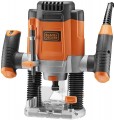Min. speed
The slowest spindle speed (in revolutions per minute) provided by the router motor.
For different jobs, the optimal spindle speed (and, accordingly, the cutter) will also be different. For example, hard materials like stone require fast rotation, but wood does not; some types of nozzles work better at high speeds, others at low speeds, etc. Detailed recommendations for each specific case can be found in special sources. Here we note that the smallest value of the minimum number of revolutions found in modern milling cutters is about 3000 – 5000, and in the most "fast" models this figure can exceed 15000. When choosing, pay attention not so much to the minimum rotation speed as to the total speed range — how it corresponds to the planned tasks.
Max. speed
The highest spindle speed provided by the router motor. Measured in revolutions per minute. For models that do not have speed control (see "Functions"), this paragraph indicates the standard number of revolutions.
For different work, the optimal speed of rotation of the spindle (and, accordingly, the cutter) will also be different. For example, hard materials like stone require fast rotation, but wood does not; some types of nozzles work better at high speeds, others at low speeds, etc. Detailed recommendations for each specific case can be found in special sources. When choosing, it is worth paying attention not so much to the maximum rotation speed as to the general range of speeds - how much it corresponds to the planned tasks. We only note that in models with a large allowable cutter diameter (see below), the maximum rotation speed can be relatively low - the working edge of a large cutter moves quickly even at low speeds, and for effective acceleration of such a nozzle, too much power would be needed.
Max. cutter diameter
The largest diameter of the cutter that can be installed in the router.
The larger the cutter, the faster its cutting edge moves and the more material it can capture, but larger nozzles require more torque. Accordingly, the maximum diameter of the cutter is directly related to the power of the tool (see above): the larger the allowable size of the nozzle, the more powerful and advanced, usually, the router is. However, large cutters (as, in fact, high power) are not always really needed. Therefore, when choosing according to this parameter, it is worthwhile to adequately evaluate the upcoming work and not chase the maximum size.
Stroke
The distance by which the height of the cutter can change relative to the support platform of the router, in other words, to what depth the working nozzle can be lowered relative to the upper position. This parameter is used for vertical and edge models (see "Type"); however, edge routers with height adjustment are very rare. In fact, the amount of travel not only describes the maximum working depth provided by the tool, but also indicates the presence of depth adjustment; for models without such adjustment, this parameter is not indicated at all.
As for specific numbers, for simple household work, a stroke of 25–30 mm is considered quite sufficient, and in a more serious tool, values of 70–80 mm can be found.
Power cord length
The length of the power cord provided in the design of the router.
The long cord, on the one hand, allows the tool to easily “reach” quite remote sockets, provides additional freedom of action and eliminates the need to switch to another socket once again. On the other hand, it can be inconvenient if the power source is not far away and the excess cord has to be stored on the floor, chair, etc.; and with insufficient length, it is quite possible to use an extension cord. Therefore, in most modern routers, the length of the cord is about 2 – 4 m — this is quite enough to reach the outlet in most cases, and at the same time not so much that there is inconvenience due to the large excess.
Noise level
The noise level produced by the router during operation. This parameter is quite approximate, since the actual “loudness” depends not only on the characteristics of the tool itself, but also on the material and shape of the workpiece being processed, the type of cutter, the speed of work, etc. Therefore, in fact, the noise level may differ both up and down; in the characteristics, a certain average value is given, by which, however, it is quite worthwhile to navigate.
The “quieter” the tool, the more comfortable it will be to work with it, the less likely it is that the operator will need protective headphones. At the same time, we note that routers, by definition, are quite noisy — the most “quiet” models give out about 75 dB. Also, keep in mind that the decibel is a non-linear quantity, so it is best to use comparison tables when estimating the noise level.
Here is a simplified version of such a table for the range in which most modern routers operate:
75 dB — scream, loud laughter at a distance of 1 m;
80 dB — motorcycle engine, mechanical alarm at the same distance;
85 dB — a loud cry at the same distance;
90 dB — demolition hammer at a distance of 1 m, a freight car at a distance of 7 – 10 m;
95 dB — subway car (inside or at a distance of about 7 m).

